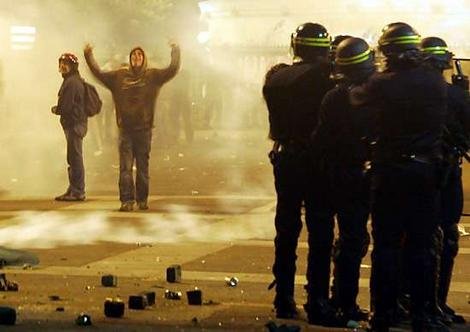
San Francisco Ballet in Tomasson's Nutcracker.
© Erik Tomasson
reprinted by permission
When the clockmaker Uncle Drosselmeyer appeared with his white hair swept up in a punkish block opening night Thursday at San Francisco Ballet's Nutcracker at the War Memorial Opera House, it was a small but radical signal. Artistic director Helgi Tomasson and Damian Smith, who inhabited Drosselmeyer with sly ingenuity, were jettisoning the tame avuncular wizard of the past. In his place they offered us a far more powerful and daring figure: the edgy artist-wizard,whose powers can transform our experience of reality.
The liberation of Drosselmeyer in San Francisco Ballet's four-year-old retooled "Nutcracker" was only one of many small knowing changes that made the night's first half -- that historic clunker in almost every production -- a deep pleasure. But it was the significant change that allowed the action of Act I to take on a clarified, poetic air.
Whether it was the pacing of the dances, the way the naughty boys behaved, or Clara's interactions with her father and Drosselmeyer -- Drosselmeyer kept the action circling in on the young girl's coming of age. Clara, danced by a budding Lacey Escabarto, aptly engaged both her father (mustachioed Val Caniparoli resembling Robin Williams) and her godfather with a mix of adoration, awe and bravery.
Drosselmeyer, meanwhile, hypnotized children and adults alike with his outsized toys and effortless magic. Even though the cannon failed to explode during the battle scene and the mousetrap proved feckless, the wizard prepared us for a new rash of spells when King and Queen of the Snow, Pierre-Francois Villanoba and a suitably grand Sarah Van Patten, appeared. With the Waltz of the Snowflakes (and a wild onstage blizzard), Drosselmeyer pulled the audience into Act II, where the wizardry finally subsided and pure dance took over.
Although packed with beautiful design and lovely dancing, Act II's magic is far more intermittent. Here, a time-traveling, dreaming Clara watches exotic spectacle after exotic spectacle, but dreamtime seems all too linked to the alarm clock. The Sugar Plum Fairy's dance, performed by Rachel Viselli, still looks schematic. Viselli, who has a lovely quietude,was also visibly nervous in the role, with consequences for her neck down into her legs. It made one want to call out -- "It's OK, Rachel, it's just a dream."
The famous divertissement of "Spanish," "Arabian,""Chinese," and "French" whirled by, distant seeming, with only "Russian" reading across the footlights as bravura dancing and dance making. Hansuke Yamamota in "Spanish," and Pascal Molat in "Chinese" nevertheless fired up the stage.
By contrast, Louis Schilling as Madame du Cirque (one part Carol Channing to two parts Divine), seemed to have all the time in the world, and her Buffoons -- tiny dancers from the Ballet School -- stopped the clock with their charm. The Waltzing Flowers luxuriated in the sunny light of the hot house they inhabited but they never seemed otherworldly.
(San Francisco Ballet in Tomasson's Nutcracker. © Erik Tomasson)

It wasn't until the Grand Pas de Deux by petite firebrand Maria Kochetkova and Davit Karapetyan that magical Tchiakovsky again met lush, magical dancing. Armenian-born Karapetyan is an athletic yet lyrical dancer who can combine geometrically pure virtuosity with a certain warm irony, as he did Thursday during the Grand Pas de Deux. His turns in second rotated with clockwork surety, and his leaps and beats were preternaturally secure. He partnered Russian-born Kotchetkova, who combined a sparkling blend of robust attack and precise lyricism, effortlessly. And it was then that full magic of "Nutcracker" returned, the pair sewing up the night with enough wizardry to meet Drosselmeyer toe to toe.












